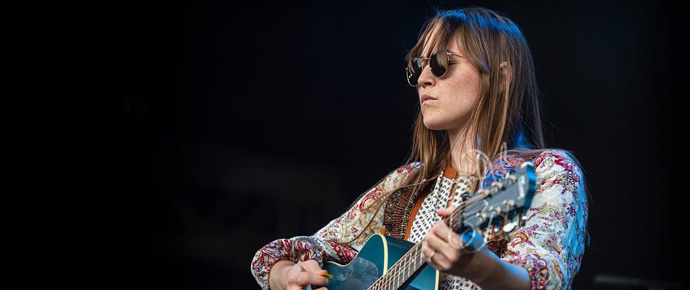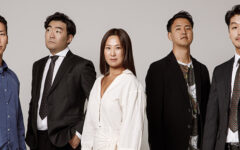
Malin Petersen is what some folks might refer to as bi-continental. Raised in Norway by parents that considered themselves steadfast music lovers — her dad being a country musician and her mother a lover of jazz — she began her own musical career at the helm of a group called Lucky Lips, a combo that was so popular in her native Norway that it went on to record three well-received albums, and won a spot competing in the Eurovision Song Contest in 2013, and eventually at AmericanaFest five years later.
Lucky Lips was initially formed while its founding members were still in still school. Then, when they begin thinking about how to take their music to a wider audience, bluegrass became their main means of expression. “We’re talking a modern kind of bluegrass, with punchy three-part harmonies, and even a full drum kit for parts of its existence,” Petersen recalls. “At the time, they had different people playing with them, depending who was free for each show, but they ended up falling in love with the genre and wanting to write their own material and to put an actual band together. After one of the founders quit, they asked me if I wanted to join, telling me they were in the process of starting to write their own material for the first time.”
The timing was ideal as far as Petersen was concerned. “I was 19 at the time and had been writing for a while, but hadn’t done much of my original stuff with a band. So it was such a great way to start merging my songwriting with actually being able to perform the songs I wrote while becoming more familiar with the band setting. When I joined, the rest of the band members had just fallen into place — Pål Emil Storm Berg on drums, Erlend Skullestad Hølland on upright bass, Even Reinsfelt Krohg played banjo, and Stian Sveen played guitar. Heidi Nyheim and Signe Marie Sørensen were the two founders who were still in the band when I joined. In 2011 Heidi and Signe left the band, and as the rest of us were considering how to move forward as a group we went to play the European World of Bluegrass event in Holland where we were named the number one European Bluegrass Band in 2011. We dropped a plan to change our name and we kept moving forward as a five-piece. We’re still going strong today, even though we’ve become a bit more amplified these past few years.”
Those efforts have served the band well. They’ve toured throughout Norway, through parts of Europe, and even managed to play some prestigious venues in the US including the Station Inn in Nashville, the site of their AmericanaFest showcase. “We’ve really played all kinds of venues, from the really tiny ones with beer-stained floors, to medium ones, up to really big stages as well. But overall, the stages we usually play are the typical venues that have a following of music enthusiasts who really like going to live shows and checking out new music as well as personal favorites. We have played some pretty big festivals in Norway, but it has taken some time to get into the really big pop/rock-oriented ones. It’s been getting a lot better the last couple of years though, and our collaboration with Norwegian guitarist Amund Maarud has also opened some doors for us.”
In addition to Lucky Lips, Petersen has also had a successful solo career. She made her initial bow courtesy of an album entitled References Pt. 1, and the effort was so successful it earned her country’s Spellemann Award, which is the equivalent of a Norwegian Grammy. She followed that with Alonesome in 2019, a mini set that reaped her any number of critical kudos and an Ameripolitan Awards nomination as well. It also lured her to Nashville where she recorded het upcoming album Wildhorse, due out in October.
Yet, while Petersen has expanded her template, her initial influences made her a bluegrass devotee early on, and the seminal sounds she listened to growing up still hold sway. Its primary appeal informed her early on, and, she says, became part of her listening library even in her early teens.
“When I was 14 or 15, my dad gave me a bag of CDs he thought I should hear,” Petersen recalls. “And in there was everything from Lucinda Williams, Emmylou Harris and other great country and Americana artists, to Alison Krauss and Union Station, The Chicks, and Dolly Parton’s bluegrass album The Grass Is Blue. I was amazed by the harmonies and how the melody and the rhythm seemed to be so intertwined, especially on the bluegrass-related albums. And I was definitely very drawn to the vocal style and the phrasing. When I got the call from Lucky Lips — whom I had heard live only weeks earlier — and they said they were looking for someone to join their bluegrass-inspired band, it was easy to say yes. Working with them would introduce me to bluegrass in a bigger sense, and I was soon working my way through Bill Monroe, The Stanley Brothers, Flatt & Scruggs, The Seldom Scene, The Lonesome River Band, The Infamous Stringdusters, and Hazel and Alice, amongst many more. Brennen Leigh has also been a huge influence on me since I was 17, and she taught me a lot through her own music and the music she would listen to and talk about. These days I’m listening to Rhiannon Giddens’ different projects, and I’m having a love affair again with I’m With Her’s album from 2018.”
Petersen says there is an audience for bluegrass in her native Norway and though it’s modest, it’s still enthusiastic. “A cool thing about the bluegrass audience here — just like in the rest of the world — is that they meet up, they’re engaged, they support their favorite bands, and share the same enthusiasm for the music as the bands do. I also think the actual bluegrass audience is bigger than those who would define themselves as being into bluegrass. I think there are many fans of bands like Mandolin Orange here who could definitely find more bands with bluegrass related music that they could like, only they might not know about them because they are not presented to them on a lot of the bigger music platforms. I seem to meet people all the time who get really excited when meeting someone else who also likes bluegrass because they don’t know anyone else who does. But we are not many enough — yet — to be considered a significantly big audience. We do have some pretty huge country festivals here though, where bluegrass also gets a platform.”
It’s significant, then, that Petersen finds a special connection between bluegrass and the folk music found in her country. Much of it has to do with the use of the fiddle as primary instrumentation.
“We have long and deep traditions with the fiddle,” she notes. “I’ve heard stories told of old fiddle tunes from Norway that have traveled the sea, been passed on, and can be found played in the US today. I wish I had details, and I bet the versions have changed over time, but one of the things I love about American music is that it carries so much history and tradition from all over the world. We can find pieces of our own history across the Atlantic.”
She says that there are various other ties as well. “Storytelling is also a very important part of the Norwegian folk tradition,” Petersen reflects. “Factual stories of tragic events, love stories and feuds… just like the music that traveled to the US from places like England, and would eventually become the framework of old-time music… and which would become forever welded together with the music that traveled from central and western Africa and create the groundwork of the music that we love so much.”
Petersen cites a number of other groups from Norway that have taken a similar stance. “We have bands like the fantastic Strengeplukk and Ila Auto, who sing in Norwegian, and great groups like Buster Sledge, Earlybird Stringband, and Winding Road. We also have artists like Jonas Fjeld who has recorded albums with both Chatham County Line and Judy Collins. Jeff Wasserman is an American living in Norway who has released old-time music. And there are bands like Darling West who have expanded their sound on their newer album, but who definitely have a bluegrass/old-time feel to several of their albums and songs. The scene isn’t that big, so it’s difficult to get the bigger gigs in this genre, but I love that we still have new bands popping up, and other bands use elements of bluegrass in their sound while helping to spread the word about its existence. Hopefully, it will just keep going.”
Indeed, Petersen finds plenty of reasons to relate to bluegrass, all of which she believes contribute to its ongoing international popularity.
“I think the reason it came into being explains a lot of why it’s become so popular,” she muses. “It tells our story. It makes us feel like we are related to the past, and thus make us feel like people in the future will feel a relation to us. That makes it feel like it still matters. And no matter where you are from, I think you can relate to many of the stories being told about situations and events and feelings that, in some form or shape, are repeated all over the world. It’s also such a social form of music, just like our folk music is here in Norway. It can be passed down through the generations. You can sit and play together in small and large groups, and people are encouraged to play solos, even when they’re not great at playing because everyone else knows that it’s such an important part of developing skill and timing.”
In that regard, Petersen believes that are important lessons to be learned as well.
“As I explored the history of bluegrass more and more while growing up, I learned things that I think are under-communicated in the wider bluegrass community, such as the banjo being of African origin,” she surmises. “There are things we need to do to make sure we do not repeat themselves as we move forward in time – such as recognizing that mid-century bluegrass festivals and venues were often segregated, which made it difficult, not only for black bluegrass fans to attend or black bands to play, but also for black and white musicians to play in bands together. It resulted in the white musicians being able to prevail and go out on tours all over the US, while black fans and musicians never got those same opportunities. As a result, people today might think bluegrass is a white genre, which is a shame since it is so intertwined with music that originated in Africa, and with black American musicians and the collaboration that existed between black and white musicians. We need bluegrass to be the thing that created it – a space where the love of music overshadows any other movement in society trying to keep people apart. When I look at my early influences it’s almost only white men, and they are amazing, but they are also the ones who were the easiest to sell and those who were the freest to leave their homes to go touring. The bluegrass of today needs to be for everyone, and it needs to be aware of its history.”







